Leopold Ahrendts Paintings
Leopold Ahrendts was a German photographer known for his architectural and landscape photographs. Born in 1825 in Berlin, Ahrendts began his career as a lithographer but quickly developed an interest in the emerging field of photography. In the early days of photography, techniques were still being perfected, and Ahrendts became one of the early adopters and practitioners of the new art in Germany.
In the 1850s, Ahrendts established himself as a professional photographer, capturing the rapidly changing face of Berlin. His work from this period is of particular historical interest as it provides a visual record of the city during a time of significant transformation when Berlin was evolving from a modest town into an important European capital. Ahrendts was recognized for his meticulous compositions and his ability to capture the architectural grandeur and urban transformation of his time.
He was particularly adept at using the collodion wet plate process, a popular photographic technique of the era that involved coating a glass plate with a light-sensitive silver salt solution. This process, although cumbersome, allowed for a level of detail and clarity that was unparalleled at the time. Ahrendts’ skill in using this technique enabled him to produce images with exceptional sharpness and depth.
Throughout his career, Ahrendts contributed to the field of photography not only through his artistic works but also through technical innovation. He experimented with panoramic photography and was one of the first to capture comprehensive views of cityscapes, which were particularly popular among the burgeoning middle class eager to own representations of their modernizing city.
Leopold Ahrendts' work was widely appreciated during his lifetime, and he participated in various exhibitions, gaining recognition from both the public and his peers. Unfortunately, his life and career were relatively short-lived; he died in 1870. Despite this, his legacy endures through his photographs, which continue to be valuable both as works of art and as historical documents of the urban landscape of 19th-century Berlin.

